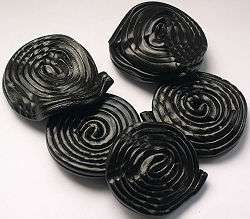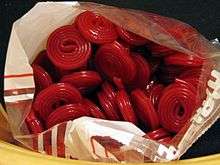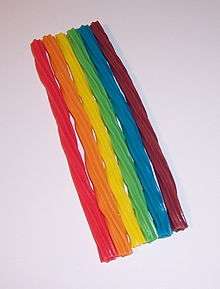Liquorice (confectionery)
Liquorice (British English) or licorice (American English) (/ˈlɪkərɪʃ, -ɪs/ LIK-ər-is(h))[1] is a confection usually flavoured and coloured black with the extract of the roots of the liquorice plant Glycyrrhiza glabra. A wide variety of liquorice sweets are produced around the world. In North America, black licorice is distinguished from similar confectionery varieties that are not flavoured and coloured black with liquorice extract but commonly manufactured in the form of chewy ropes or tubes. So called "black licorice" together with anise extract is also a widespread flavour in other forms of confectionery such as jellybeans. In addition to these, various other liquorice-based sweets are sold in the United Kingdom, such as liquorice allsorts. Dutch and Nordic liquorice characteristically contains ammonium chloride instead of sodium chloride, prominently so in salty liquorice.
 Liquorice wheels | |
| Alternative names | Black licorice |
|---|---|
| Type | Confectionery |
| Main ingredients | Extract of the roots of the liquorice plant, sugar, binding agent (starch, flour, gum arabic, or gelatin) |
The essential ingredients of black liquorice confectionery are liquorice extract, sugar, and a binder. The base is typically starch/flour, gum arabic, gelatin or a combination thereof. Additional ingredients are extra flavouring, beeswax for a shiny surface, ammonium chloride and molasses. Ammonium chloride is mainly used in salty liquorice candy, with concentrations up to about 8%. However, even regular liquorice candy can contain up to 2% ammonium chloride, the taste of which is less prominent because of the higher sugar concentration.[2] Some liquorice candy is flavoured with anise oil instead of or in combination with liquorice root extract.[3]
Production
During manufacturing, the ingredients are dissolved in water and heated to 135 °C (275 °F). In order to obtain sweets of the desired shapes, the liquid is poured into molds that are created by impressing holes into a container filled with starch powder. The liquid is then dried and the resulting sweets are sprayed with beeswax to make their surface shiny.[4]
Health effects

The liquorice-root extract contains the natural sweetener glycyrrhizin, which is over 50 times sweeter than sucrose. This ingredient has various pharmaceutical properties. It acts as an expectorant (facilitating removal of mucus from the lungs by coughing) and it increases blood pressure. The latter effect can become significant with a daily consumption of 50 g or more of liquorice candy for as little as two weeks.[5] Glycyrrhizin can cause potassium levels in the body to fall, triggering abnormal heart rhythms, as well as high blood pressure, edema (swelling), lethargy, and congestive heart failure in some people.[6]
Liquorice has several varied uses in herbal medicine, such as acting as a mild laxative by increasing prostaglandins.
Comparative studies of pregnant women suggest that excessive amounts of liquorice (100 g a week) may adversely affect both IQ and behaviour traits of offspring.[7]
Some people report that black liquorice confectionery causes their stools to become green,[8] although this is probably due to the blue food colouring used by many manufacturers.[9][10][11][12][13]
Alexander the Great supplied his troops with rations of liquorice root whilst marching because of its thirst-quenching qualities.[14]
An excessive amount of black liquorice consumption can cause a chloride-resistant metabolic alkalosis.
Red liquorice

In many countries there is also a product sometimes known as red liquorice which is extruded in a way to resemble liquorice strings but made with main flavourings other than liquorice, such as strawberry, cherry, raspberry, or cinnamon. More recently similar products have been introduced in a wider variety of colours and flavours including apple, mango, blackcurrant, and watermelon, among others. While the common name for this confectionery has now become "red liquorice" or often simply "liquorice", it does not have the taste of liquorice. "Black" in "black liquorice"/"licorice" would formerly have been redundant and has become a retronym in North America.
Notable varieties

- Choo Choo Bar
- Crows
- Good & Plenty
- Liquorice allsorts
- London drops
- Vigroids (Nigroids)
- Pontefract cake
- Sugarelly, a liquorice drink
- Salty liquorice (Salmiak liquorice, a specialty popular in Finland)
- Turkish pepper
- Negro (candy)
- Twizzlers, the 1845 original ones
See also
References
- "Liquorice". Merriam-Webster Dictionary.
- The Dutch manufacturer Meenk offers detailed ingredient lists of its products: regular Archived 30 September 2007 at the Wayback Machine and salty Archived 30 September 2007 at the Wayback Machine liquorice candy (in Dutch).
- Black Licorice: Trick or Treat? from US Food & Drug Administration, Consumer Updates, 25 Oct 2011.
- Perry Romanowski, How Products are Made: Licorice, at enotes.com
- Sigurjónsdóttir, H Á; Franzson, L; Manhem, K; Ragnarsson, J; Sigurdsson, G; Wallerstedt, S (2001). "Liquorice-induced rise in blood pressure: a linear dose-response relationship". Journal of Human Hypertension. 15 (8): 549–52. doi:10.1038/sj.jhh.1001215. PMID 11494093.
- Black Licorice: Trick or Treat? from US Food & Drug Administration, Consumer Updates, 25 Oct 2011.
- Räikkönen, Katri; et al. (2009). "Maternal Licorice Consumption and Detrimental Cognitive and Psychiatric Outcomes in Children". Am. J. Epidemiol. 170 (9): 1137–1146. doi:10.1093/aje/kwp272.
- Stool color: When to worry
- Green Poop: The Implications Of Food Dye On Poop Color
- The Scoop on Poop, by Dr. Brenna E. Lorenz, − Division of Natural Sciences, University of Guam
- Amber J. Tresca, About.com, http://ibdcrohns.about.com/cs/otherdiseases/a/greenstool.htm
- "More Poop | Critical QQ". Criticalqq.wordpress.com. Retrieved 22 March 2014.
- Post a Question. "Dark green feces. – Nutrition". MedHelp. Retrieved 22 March 2014.
- Pearce, Ed (2004). Food for Thought: Extraordinary Little Chronicles of the World. New Alresford: O Books. p. 31. ISBN 978-1-903816-86-8.
Sources
| Wikimedia Commons has media related to Liquorice sugar confectionery. |
- Liquorice at www.food-info.net